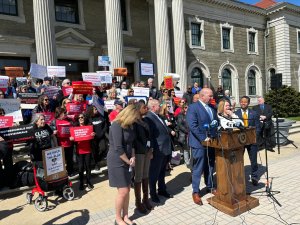Long Island’s nonprofits help many of the region’s most vulnerable populations, from the homeless to those with disabilities. So when New York State decided to hike the minimum wage, some people served by local nonprofits started earning more.
Groups typically see that as good news. But something else happened: Nonprofits themselves sometimes face higher costs due to the hike. Groups in general want employees to make a higher minimum, but employers also want to make sure they are reimbursed if their costs rise — and that often is not the case.
“Of course, we want our communities to be able to earn a living wage,” says Rebecca Sanin, president and CEO of the Health and Welfare Council of Long Island, a Melville-based umbrella agency for hundreds of nonprofits. “And there’s value in increasing the minimum wage.”
As minimum wages rise statewide, Long Island’s rose to $10 an hour at the end of 2016, $11 at the end of 2017 and $12 an hour at the end of 2018. It’s slated to hit $13 at the end of this year, $14 at the end of 2020 and $15 at the end of 2021.
The other side of the proverbial coin means some nonprofits pay more — while not necessarily receiving more as contracts remain flat.
“The challenge is when you talk about nonprofits with hourly employees, perhaps childcare providers and other folks,” Sanin says. “They could be significantly impacted when there’s an increase in wages, but not contracts.”
Stanfort Perry, executive director of Brookville-based AHRC Nassau, leads a group which, including affiliates, employs 3,200 and has a budget of more than $220 million.
“Because we rely on government funding for our survival, we cannot raise the price of the services we provide,” Perry says. “We rely on government and legislators to pass bills that fund appropriately the services for the neediest folks on Long Island.”
Groups that pay more than minimum wage in some cases are reimbursed at minimum wage, so a hike in minimum means they’re reimbursed more. But contracts often span multiple years without mechanisms to make adjustments based on rising wages.
“Government contracts need to reflect that wage increase,” Sanin adds.
Nonprofits have to find other ways to make up for shortfalls, possibly ramping up donations.
“It puts a significant burden on the need to fundraise for additional dollars,” Sanin says. “Organizations already are working on tight budgets.”
LI nonprofits face other challenges since the region’s “demographics have shifted dramatically,” Sanin says, changing the mix of services needed.
“We are continually getting increases in the cost of health insurance, general liability coverage, workers compensation, utilities,” Perry, who would like to see cost of living increases built into agreements, adds. “Those costs continue to go through the roof.”
At the same time, some contract amounts decrease, putting pressure on bottom lines.
“You make adjustments as necessary. Many agencies have to lay off people,” Perry says, noting his has not. “Agencies are merging, because they can’t stand alone to provide services.”
Volunteering remains a key component in the nonprofit mix. The New York State Department of Labor notes nonprofits’ “volunteers, students, trainees, or learners/apprentices” often are exempt.
Low unemployment can make it tougher to recruit qualified workers, Perry adds. And the cap on state and local tax deductions impacts donors and those in need.
“A very significant amount of folks owed money for the first time in their lives or had reduced refunds,” Sanin says. “Traditionally their family had relied on those to catch up with bills.”
Nonprofits continue to extend a safety net, helping those in need and, in most cases, meeting their own needs, although they want to make sure that as mandates increase, payment keeps pace.
“We find a way,” Perry says. “We work with government as our partners to make sure we continue to grow and develop new opportunities.”




























